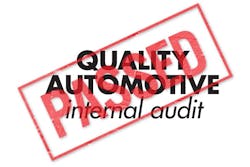Audit. Now there’s a word that immediately strikes fear into every business owner and accountant.
But I am not talking about that kind of audit. I’m talking about audits that are more of a check-up for your shop. There are three main audits I practice and recommend to shop owners and managers. Why? You have probably heard the phrase “continuous improvement.” When applied to body shops, continuous improvement simply means doing high-quality work faster and with fewer expenditures. The following audits are a simple yet powerful tool to achieve this.
Audit 1: Image
Have you ever looked at your facility as if you are seeing it for the first time?
This audit starts in the parking lot. I recommend you take an estimator or customer service representative along for this one. Start in the parking area and simply imagine you are a customer coming in for an estimate. Is there adequate room for parking? Is where to park clearly marked? Is the parking area clean and free of garbage and broken parts? Now this is not to say that it’s a bad idea to put a wrecked car out front. Sometimes that is not only necessary but also good. I have had several occasions when people will see a severely damaged car and say, “You can fix that?” This is not only a conversation piece, but it also gives customers confidence that fixing their fender should be a piece of cake for your shop.
Next, is it clearly marked how to enter your building? What do people see as they enter? Hopefully they will see a smiling face ready to greet them and help them. Are there piles of paper on the desks? Is the space dirty and dusty or clean and tidy? Right or wrong, people will assume that how things look in your office is how their car will look when it is delivered.
Audit 2: Online
Next, take a look at your website. Does it clearly tell people what you do, where you are located and how to get in touch with you? Your homepage should function more like a landing page than a typical website. Landing pages give just basic information and have a call to action. What do you want people to do once they land on your site? Call you for an estimate? Fill out an online estimate form? Email you? Lead them to do one thing and tell them visually how to do it. For instance, if you want them to call you, put your phone number inside a large red box with an arrow pointing to it saying, “Call now for an estimate.” Do not leave them wondering what they should do next.
Audit 3: Cars
The third and most obvious audit is to audit jobs. This for us has been a great training ground for new estimators and fodder for discussion between techs and managers. And it’s really simple: Just pull a file of an active job, go to the car with a copy of the estimate in hand and start looking it over, line by line. This gives an opportunity to talk to the technician and thank them for doing a great job, or to ask them a question about something that may have been overlooked. The highest value might be simply that there are multiple eyes on the job that will all see things a bit differently and that’s where learning takes place.
It’s also important to audit jobs right after being painted. This way you can see how cars look while disassembled and not yet primed. This is also a great time to see how clean a paint job is and check for overspray.
One final suggestion about audits: Keep them random and keep them low-key. Obviously it would be too time-consuming to thoroughly audit every car with multiple people, in different departments having conversations all along the way. But keeping them random will drive a higher accountability as techs will not know which jobs will be audited and it allows for a deeper conversation and learning if you only do a couple a week.
And keep it low key. This is not a time for chewing out a tech for something missed or making a lesson of someone’s performance. If there are patterns you observe over time with a particular technician, of course that needs to be challenged. The main point of an audit is for individuals to learn and grow, and for the shop to improve overall performance.
About the Author

Kevin Rains
Kevin Rains is the owner of Rains CARSTAR Group with locations in Cincinnati, Ohio; West Chester, Ohio; and Lexington, Kentucky. He is also an industry consultant. He can be reached at [email protected].
